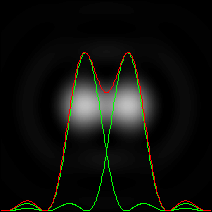

The EJS Optical Resolution model computes the image from two point sources as seen through a circular aperture such as a telescope or a microscope. The simulation allows the user to vary the distance between the light sources and the diameter of the aperture, as well as the intensity of the light source. For a single point source, the central circular maximum, called the diffraction spot or Airy disk, has an angular half width determined by

For two point sources, as the distance between the point decreases, the diffraction patterns begin to overlap until eventually they become undistinguishable and it is no longer possible to determine if there are one or two images. According to the Rayleigh criterion, two images are resolvable when the center of the diffraction maximum of one image is aligned with the first minimum in the diffraction pattern of the second image.
The aperture simulation was created by Fu-Kwun Hwang using the Easy Java Simulations (EJS) modeling tool. It was adapted to EJS version 4.0 by Robert Mohr at Davidson College. You can examine and modify the model for this simulation if you have Ejs installed by right-clicking within the wave function plot and selecting "Open Ejs Model" from the pop-up menu. Information about EJS is available at: <http://www.um.es/fem/Ejs/> and in the OSP ComPADRE collection <http://www.compadre.org/OSP/>.